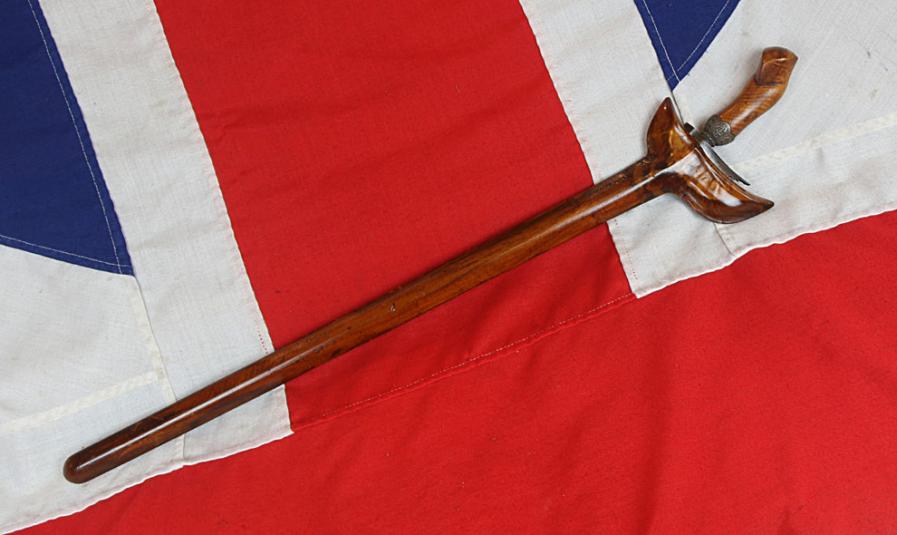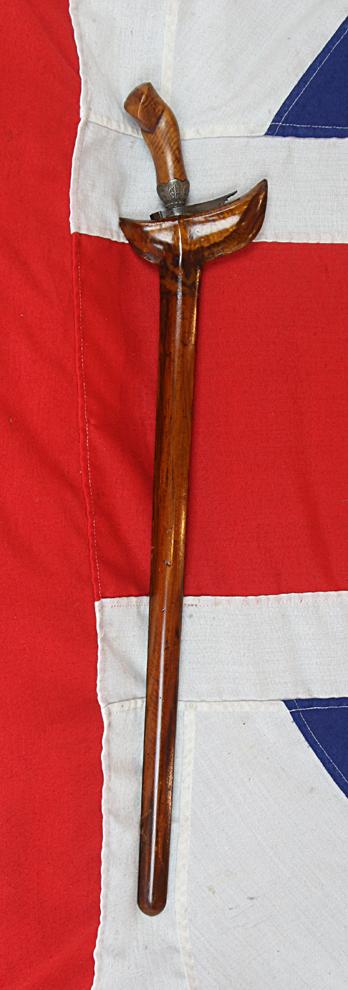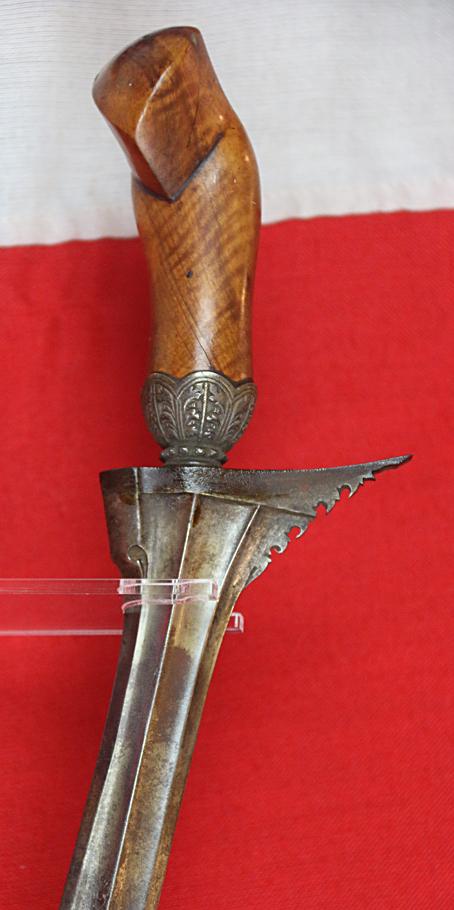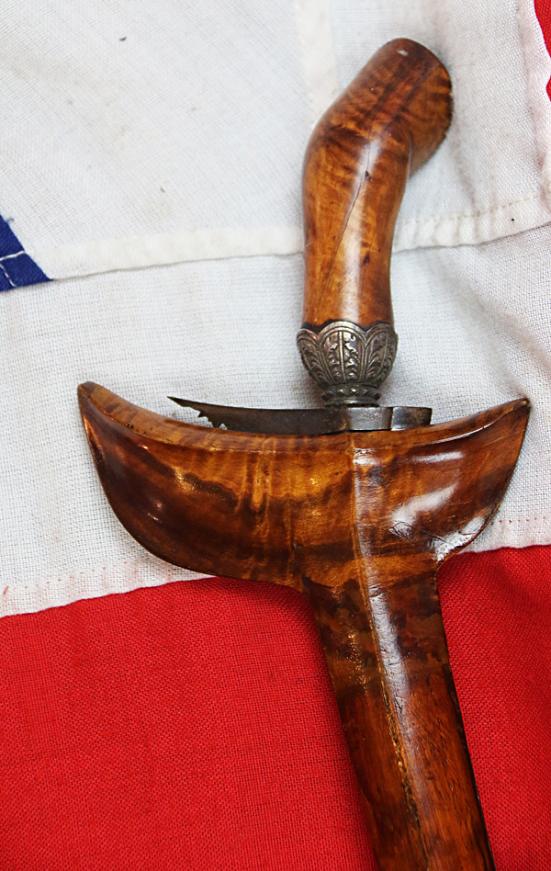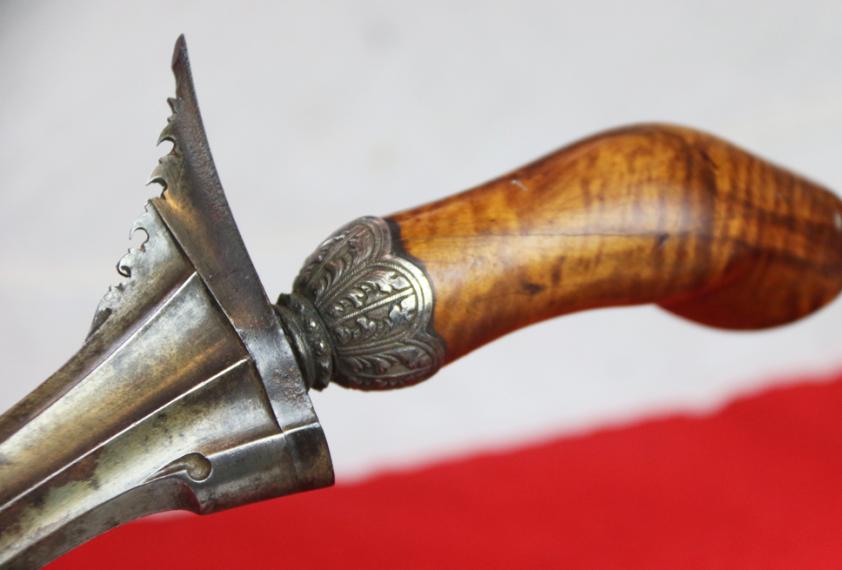An Original Antique Executioner's Keris Behari, Alang Pehang, From Indonesia Most Likely Sumatra For Hukuman Salang
The kris also known as keris is called a wilah or bilah. Kris blades are usually narrow with a wide, asymmetrical base. The kris is famous for its wavy blade; however, the older types of kris dated from the Majapahit era have straight blades, and they are the types, such as this one that were used for ceremonial executions.The execution by keris is called hukuman salang. Salang is synonymous with keris panjang.The executioner made the victim to squat then drove the keris panjang from certain spot inside his collar bone down to the heart. The number of luk or curves on the serpentine regular keris blade is always odd. Common numbers of luk range from three to thirteen waves, but some blades have up to 29. In contrast to the older straight type, most kris have a wavy blade which is supposed to increase the severity of wounds inflicted upon a victim. During kris stabbing, the wavy blade severs more blood vessels, creating a wider wound which causes the victim to easily bleed to death.
According to traditional Javanese kejawen, kris contain all the intrinsic elements of nature: tirta (water), bayu (wind), agni (fire), bantolo (earth, but also interpreted as metal or wood which both come from the earth), and aku (lit: "I" or "me", meaning that the kris has a spirit or soul). All these elements are present during the forging of kris. Earth is metal forged by fire being blown by pumped wind, and water to cool down the metal. In Bali, the kris is associated with the naga or dragon, which also symbolizes irrigation canals, rivers, springs, wells, spouts, waterfalls and rainbows; thus, the wavy blade symbolizes the movement of the serpent. Some kris have a naga or serpent head carved near the base with the body and tail following the curves of the blade to the tip. A wavy kris is thus a naga in motion, aggressive and alive; a straight blade is one at rest, its power dormant but ready to come into action.
In former times, kris blades were said to be infused with poison during their forging, ensuring that any injury was fatal. The process of doing so was kept secret among smiths. Different types of whetstones, acidic juice of citrus fruits and poisonous arsenic bring out the contrast between the dark black iron and the light coloured silvery nickel layers which together form pamor, damascene patterns on the blade. The distinctive pamor patterns have specific meanings and names which indicate the special magical properties they are believed to impart"The Kris Panjang is worn generally by the Malayan aristocracy, and bridegrooms. I have seen some beautiful specimens of this weapon in Rumbowe, worn by the chiefs of that state. The blades resembled that of a long keen poniard, of Damascus steel; the handles of ebony, covered with flowered gold, and sheaths richly ornamented with the same metal: they are used in the execution of criminals."
Thomas John Newbold, in 1839 wrote
."The last sentence of death passed by Abdul Syed (or Dholl Syed), the ex-Panghúlu, was on a Quedah man, named Sali, in 1805. This Malay had carried off from Malacca two Chinese slaves, a man and a woman; meeting some resistance from the former, he murdered him with his kris, in the forest of Londu, and proceeded with the woman to Pila, in Srimenanti, where he sold her as a slave. "
The present superintendent of Naning, Mr, Westerhout, who was an eye-witness, described to me the ceremony of his trial and execution. The criminal was conducted, bound, to Bukit Penialang, or "Execution Hill," near Tabu. The Panghúlu, the Ampat Suku, the twelve Panglimas, the Bandahara, and the Makdum, were all seated in judgment, under a cluster of Tambuseh trees, on the skirt of the hill.
The witnesses were brought forward, and examined by the Panghulu himself. The evidence against the prisoner being deemed conclusive, according to the forms of the Mohammedan law, he was sentenced, agreeably to the Adat Menángkábowe, to pay one Bhar, equivalent to 24 Sp. drs. 30 cents.) or to suffer (salang) death by the kris.
Being unable to pay the fine, preparations were made for his immediate execution. The grave was dug on the spot, and he was placed, firmly bound in a sitting posture, literally on its brink. For further security, two panglimas sat on each side, while the Panglima Besar Sumun unsheathed the weapon that was to terminate the mortal existence of the trembling wretch.
On the point of the poniard, the kris panjang, the panglima carefully placed a pledget of soft cotton, which he pressed against the man's breast, a little above the right collar-bone. He then slowly passed the weapon's point through the cotton, on which he kept the fingers of his left hand firmly pressed, in a direction obliquely to the left into his body, until the projection of the hilt stopped its farther progress. The weapon was then slowly withdrawn, the panglima still retaining the cotton in its place by the pressure of his fingers, so as to staunch effectually all external effusion of blood.
The criminal, shuddering convulsively, was immediately precipitated into the grave; but on making signs for water, was raised. He had barely time to apply his lips to the cocoa-nut- shell in which it was brought, when he fell back into the grave quite dead. The earth was then hastily thrown over the body, and the assembly dispersed."
-J.B. Westerhout, 1805. Blade 21 inches, overall in scabbard 27 inches
Code: 23769
795.00 GBP

